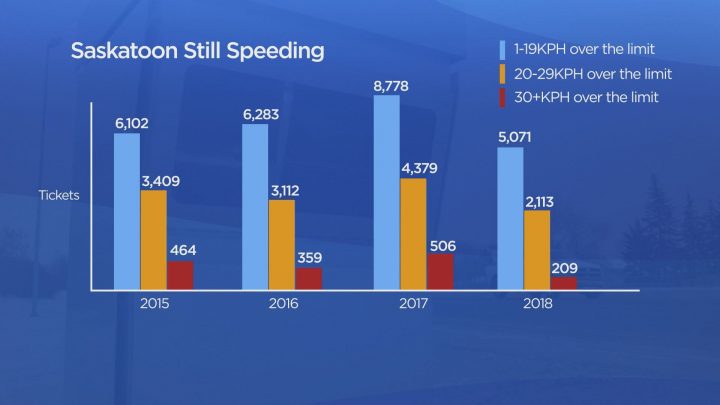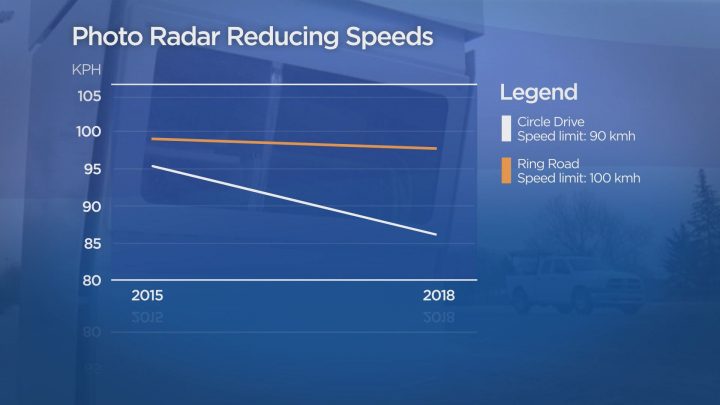On Sept. 18, Regina Police Service Const. Curtis Warnar tweeted a video of himself explaining how to get out of a speeding ticket: by following the speed limit.

“If you travel the number on the speed-limit signs, you’re not going to get a ticket,” he reiterated Wednesday to Global News.
Simple advice, but many drivers still ignore it.
In the past three years, photo radar, or Photo Speed Enforcement (PSE) as it’s officially called, has captured 122,235 speeding violations on Ring Road and Circle Drive.
Police in Regina and Saskatoon have issued over 57,000 tickets combined; but is photo radar actually stopping speeding, or is it just quick cash?
“We studied the results over the two-year period of the pilot project and what we found was that photo speed enforcement reduced speeds and calmed traffic in the areas where it was taking place and as a result, there were fewer collisions and fewer injuries.”
In Regina, the effect has been dramatic: a 34 per cent drop in tickets for people travelling between 100-119 km/h and over the limit on Ring Road since the program was introduced in 2015. The number of tickets issued to drivers speeding at 130 km/h or more dropped nearly 50 per cent.
On Circle Drive, there was a 17 per cent drop in tickets for people travelling between 100-119 km/h and despite an uptick in tickets issued in 2017, the number of people speeding was actually down by over 7,000 people that year.

Get daily National news
“What we looked at was the violation rate and we had set a target for a one per cent violation rate and that was achieved throughout the course of the pilot,” McMurchy said.
The proportion of vehicles violating the speed limit on Circle Drive in March of 2016 was 0.63 per cent. In March 2017, it had fallen to just 0.24 per cent.
Overall, the average speed on Ring Road has dropped 3.4 km/h and a startling 11.6 km/h on Circle Drive since photo radar was introduced.
While the return on investment speaks for itself on the provinces’ highways, there were also thousands of tickets issued in school zones.
In Regina, PSE resulted in 47,321 tickets issued to drivers speeding in school zones between March 2015 and July 2018. In Saskatoon, 18,347 tickets were issued for speeding in a school zone within the same timeframe.
“Saskatoon school zones operate at different times- on school days and only during certain parts of the year and certain times of day. In Regina, the school zones are seven days a week and longer hours during the day. I suspect that’s probably what accounts for the numbers and those differences,” McMurchy said.
Troy Pavelec has been collecting data on photo radar in Edmonton for years and he says the changes to traffic patterns in Saskatchewan are exactly what he expected to see.
“It really shows that photo radar in a given location, once people get used to it and understand, ‘I need to slow down here, because of tickets,’ that will cause a decrease in speed and public behaviour,” Pavelec said.
“The photo speed enforcement, the way it’s been rolled out in Saskatchewan, it’s been very transparent. If you’re entering a photo speed enforcement zone, you’re going past a very clearly marked sign that tells you that these boxes aren’t hidden,” McMurchy said.
Using a baseline of 2010-2014, SGI found that there were 28 fewer fatal collisions in areas with photo speed enforcement from 2015-2017 and a 51 per cent reduction in speed-related collisions that caused injury.
“Photo speed enforcement has always been about improving traffic safety- that’s our goal,” McMurchy said.











Comments